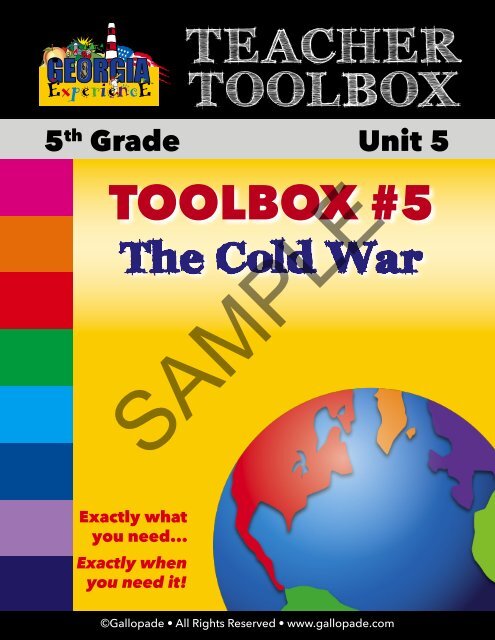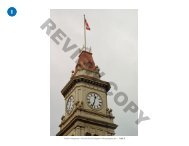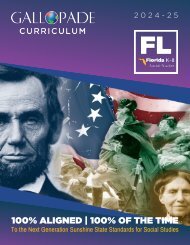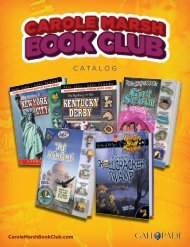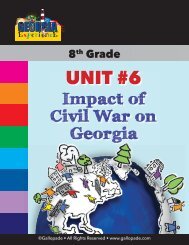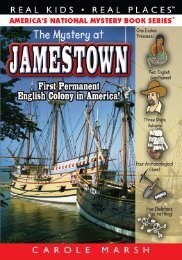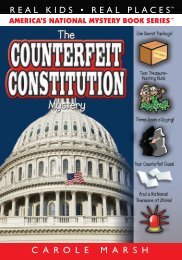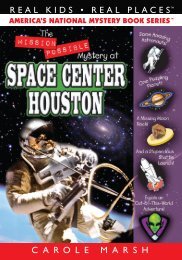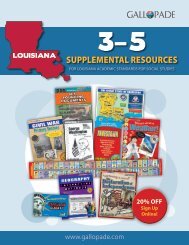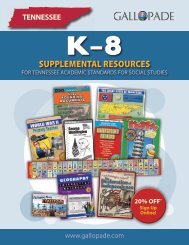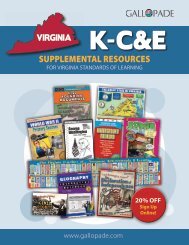You also want an ePaper? Increase the reach of your titles
YUMPU automatically turns print PDFs into web optimized ePapers that Google loves.
TEACHER<br />
GEORGIA EXPERIENCE | GRADE 5 | UNIT 5<br />
TOOLBOX<br />
5 th <strong>Grade</strong> Unit 5<br />
Social Studies Themes<br />
TOOLBOX <strong>#5</strong><br />
The Cold War<br />
Exactly what<br />
you need...<br />
Exactly when<br />
you need it!<br />
SAMPLE<br />
©Gallopade • All Rights Reserved • www.gallopade.com<br />
Permission is granted to use <strong>Toolbox</strong> only with students for whom a current-year Experience Class Set is purchased.<br />
©Gallopade • All Rights Reserved • www.gallopade.com<br />
1
UNIT 5 OVERVIEW<br />
The Cold War<br />
UNIT OR<strong>GA</strong>NIZATION<br />
& TOOLBOX SUMMARY<br />
UNIT 5: The Cold War<br />
Inquiry-Based Learning: Anticipatory Activity Unit Opener<br />
Social Studies Themes: Enduring Understandings<br />
CHAPTER 11: The Cold War Begins<br />
Learning Objectives, Correlations, Inquiry/Opener Activity, Essential Questions, Vocabulary-Builder,<br />
Instructional Strategies and Activities, Vocabulary Quiz, Study Guide, and More<br />
ExperTrack Online Assessment * : Checkpoint #06<br />
CHAPTER 12: Trying to Contain Communism<br />
Learning Objectives, Correlations, Inquiry/Opener Activity, Essential Questions, Vocabulary-Builder,<br />
Instructional Strategies and Activities, Vocabulary Quiz, Study Guide, and More<br />
ExperTrack Online Assessment * : Checkpoint #06<br />
CHAPTER 13: The Vietnam War<br />
Learning Objectives, Correlations, Inquiry/Opener Activity, Essential Questions, Vocabulary-Builder,<br />
Instructional Strategies and Activities, Vocabulary Quiz, Study Guide, and More<br />
ExperTrack Online Assessment * : Checkpoint #06<br />
SAMPLE<br />
*<br />
license required<br />
©Gallopade • All Rights Reserved • www.gallopade.com
UNIT 5<br />
GEORGIA EXPERIENCE | GRADE 5 | UNIT 5<br />
INQUIRY-BASED LEARNING<br />
ANTICIPATORY ACTIVITY UNIT OPENER<br />
Begin with Student Workbooks closed.<br />
Inquiry-Based Learning<br />
Tell students they are starting a new chapter about the Cold War.<br />
Write “The Cold War” on your whiteboard.<br />
Have students develop questions about the Cold War:<br />
• Students spend the first few minutes writing questions independently.<br />
• Then the class or small groups collaborate to create a question board.<br />
• Give students time to think of new questions that build on the questions<br />
already shared.<br />
Examples of questions your students might create:<br />
• Why is it called the Cold War?<br />
• What countries was it between?<br />
• What was it about?<br />
• Who won?<br />
• How many people died?<br />
• When was it?<br />
• How long did it last?<br />
• Where was it?<br />
• Was the U.S. involved?<br />
• How did it start? How did it end?<br />
• Are those countries enemies or friends today?<br />
• Was it a world war?<br />
• What equipment/technology/planes/etc., did they use?<br />
• If somebody won, what did they get?<br />
• If somebody lost, what did they lose?<br />
SAMPLE<br />
Record questions and answers to revisit at the end of the chapter.<br />
Differentiation:<br />
Give students who need help formulating questions a copy of Gallopade’s<br />
Question Prompts Graphic Organizer as a scaffold for their questions.<br />
©Gallopade • All Rights Reserved • www.gallopade.com<br />
Permission is granted to use <strong>Toolbox</strong> only with students for whom a current-year Experience Class Set is purchased.<br />
3
UNIT 5<br />
GEORGIA EXPERIENCE | GRADE 5 | UNIT 5<br />
SOCIAL STUDIES THEMES<br />
ENDURING UNDERSTANDINGS<br />
Social Studies Themes<br />
These themes provide the underlying framework for many important “big picture” concepts<br />
that your students will be learning throughout this unit. Use the questions to help students<br />
apply what they learn about the Cold War toward their understanding of these Enduring<br />
Understandings throughout the unit.<br />
CULTURE<br />
Culture is how people think, act, celebrate, and make<br />
rules, and that is what makes a group of people special.<br />
How did the Cold War impact American culture?<br />
INDIVIDUALS, GROUPS, & INSTITUTIONS<br />
What people, groups, and institutions say and do can help<br />
or harm others—whether they mean to or not.<br />
How did individuals, groups, and institutions react to the Cold War and the potential<br />
spread of Communism in the United States?<br />
BELIEFS & IDEALS<br />
People’s ideas and feelings influence their decisions.<br />
How did beliefs and ideals affect American society during the Cold War era?<br />
SAMPLE<br />
CONFLICT & CHANGE<br />
Conflict causes change.<br />
What global changes occurred as a result of the Cold War conflict?<br />
TECHNOLOGICAL INNOVATIONS<br />
New technology has many different consequences,<br />
depending on how people use that technology.<br />
What technological innovations developed during the Cold War era? Why?<br />
How did technological innovation impact the Cold War?<br />
How did innovations affect the role of media in the Cold War era?<br />
©Gallopade • All Rights Reserved • www.gallopade.com<br />
Permission is granted to use <strong>Toolbox</strong> only with students for whom a current-year Experience Class Set is purchased.<br />
4
CHAPTER 11<br />
The Cold War Begins<br />
CHAPTER TOOLS:<br />
Tool<br />
Multimedia Resource Gallery<br />
Learning Objectives + Correlations<br />
Inquiry-Based Learning Activity<br />
Essential Questions Activity Sheet<br />
Vocabulary-Builder<br />
When To Use<br />
(start, end, or with which page of Student Workbook)<br />
throughout<br />
start + ongoing<br />
opener; use FIRST<br />
start + ongoing<br />
start + ongoing<br />
Graphic Organizer #1 page 62<br />
Map Skill Builder page 63<br />
Leveled Literacy page 64<br />
Primary Source Analysis page 66<br />
Graphic Organizer #2 page 66<br />
Writing Prompt page 67<br />
Vocabulary Quiz<br />
Interactive Workbook Scavenger Hunt<br />
Study Guide Worksheet<br />
ExperTrack * Checkpoint #06<br />
SAMPLE<br />
EOC<br />
EOC<br />
EOC<br />
EOC (pretest optional)<br />
*<br />
license required<br />
©Gallopade • All Rights Reserved • www.gallopade.com
CHAPTER 11<br />
GEORGIA EXPERIENCE | GRADE 5 | UNIT 5<br />
Learning Objectives & Correlations<br />
THE COLD WAR BEGINS<br />
LEARNING TARGETS<br />
Students will be able to:<br />
GSE:<br />
ÎÎExplain the origin and meaning of the term “Iron Curtain.”<br />
ÎÎExplain how the United States sought to stop the spread of<br />
Communism through the Berlin Airlift.<br />
ÎÎExplain how the United States sought to stop the spread of<br />
Communism through the Korean War.<br />
ÎÎExplain how the United States sought to stop the spread of<br />
Communism through the North Atlantic Treaty Organization.<br />
SAMPLE<br />
CORRELATIONS TO STANDARDS<br />
SS5H5a, b<br />
Map and Globe Skills: 6, 7, 9<br />
Information Processing Skills: 2, 9<br />
©Gallopade • All Rights Reserved • www.gallopade.com<br />
Permission is granted to use <strong>Toolbox</strong> only with students for whom a current-year Experience Class Set is purchased.<br />
6
CHAPTER 11<br />
GEORGIA EXPERIENCE | GRADE 5 | UNIT 5<br />
THE COLD WAR BEGINS<br />
CHAPTER OPENER<br />
Inquiry-Based Learning<br />
1. Divide students into small groups.<br />
Give each group a sheet of poster paper with one of these questions written on it:<br />
• Why does conflict occur?<br />
• Who should make the rules?<br />
• How do beliefs impact actions?<br />
2. Tell students to brainstorm possible answers to the question and to write them on their<br />
group’s poster. Walk around and make sure all students are given the opportunity to share<br />
ideas. Allow your students to have 10 minutes to work on this brainstorming activity.<br />
3. As a class, discuss the questions and students’ answers:<br />
• Start with: Was it easy or hard to think of answers? Why?<br />
• Let groups take turns sharing their responses.<br />
(Tell students not to repeat answers already said by another group.)<br />
• As students share answers, write them on your whiteboard to create a<br />
comprehensive list.<br />
• Rotate through groups until all answers have been shared.<br />
SAMPLE<br />
4. Once you have finished your class discussion, tape their responses to a central location<br />
so students may revisit their responses while working through “The Cold War Era Begins”<br />
chapter.<br />
5. Periodically throughout this unit, review the questions as a class and have students suggest<br />
additions and changes to the original answers based on what they have learned. Have<br />
students write their new responses with different-colored markers so that they will be able to<br />
identify when changes were made to their original responses.<br />
6. Review these posters and answers again at the end of the chapter as part of your review.<br />
Use your classroom technology to customize how you do this activity.<br />
• Students can digitally post their answers to a class discussion page.<br />
• Groups can post answers on digital sticky notes, and you can consolidate them on<br />
a single board.<br />
©Gallopade • All Rights Reserved • www.gallopade.com<br />
Permission is granted to use <strong>Toolbox</strong> only with students for whom a current-year Experience Class Set is purchased.<br />
7
CHAPTER 11<br />
NAME: _____________________________________________<br />
GEORGIA EXPERIENCE | GRADE 5 | UNIT 5<br />
THE COLD WAR BEGINS<br />
<br />
What meaning did the term “Iron Curtain” have after World War II?<br />
Essential Questions<br />
<br />
How did this new meaning of the term “Iron Curtain” originate?<br />
<br />
What action caused the need for the Berlin Airlift?<br />
<br />
Why did the U.S. participate in the Berlin Airlift?<br />
<br />
What was the result of the Berlin Airlift?<br />
<br />
What actions led to the start of the Korean War?<br />
<br />
Why did the U.S. participate in the Korean War?<br />
SAMPLE<br />
<br />
What was the outcome of the Korean War?<br />
<br />
What was the purpose of the North Atlantic Treaty Organization (NATO)?<br />
<br />
What did the United States hope NATO would achieve?<br />
<br />
How did the Soviet Union react to the formation of NATO?<br />
©Gallopade • All Rights Reserved • www.gallopade.com<br />
Permission is granted to use <strong>Toolbox</strong> only with students for whom a current-year Experience Class Set is purchased.<br />
8
CHAPTER 11<br />
NAME: _____________________________________________<br />
GEORGIA EXPERIENCE | GRADE 5 | UNIT 5<br />
THE COLD WAR BEGINS<br />
DEFINE THESE TERMS BASED ON WHAT YOU LEARNED ALREADY.<br />
(IT’S OKAY TO FLIP BACK TO PREVIOUS CHAPTERS.)<br />
Allied Powers<br />
Vocabulary-Builder<br />
SAMPLE<br />
Axis Powers<br />
USE A DICTIONARY TO DEFINE THESE TERMS.<br />
communism<br />
democracy<br />
capitalism<br />
ideology<br />
containment<br />
Iron Curtain<br />
Berlin Wall<br />
The Cold War<br />
DEFINE THESE TERMS AS YOU LEARN THEM IN CLASS.<br />
©Gallopade • All Rights Reserved • www.gallopade.com<br />
Permission is granted to use <strong>Toolbox</strong> only with students for whom a current-year Experience Class Set is purchased.<br />
9
CHAPTER 11<br />
NAME: _____________________________________________<br />
GEORGIA EXPERIENCE | GRADE 5 | UNIT 5<br />
COMPARE & CONTRAST<br />
COMPARE & CONTRAST THE UNITED STATES AND THE SOVIET UNION.<br />
Complete the Venn diagram based on the two countries in the mid-1900s.<br />
Include these characteristics as well as others you consider important:<br />
Graphic Organizer #1<br />
• Which side each country fought on in WWII<br />
• Each country’s ideologies about government and economy<br />
• Each country’s status/strength after WWII<br />
• Each country’s actions after WWII<br />
To add it to your workbook, cut along the dashed line, and fold on the solid line.<br />
Put glue on the BACK of the striped area, and glue it to the top of page 62.<br />
Glue it so it is readable when flat, and you can fold it upwards to read the workbook page.<br />
put glue on the BACK of this striped section<br />
United States<br />
BOTH<br />
Soviet Union<br />
SAMPLE<br />
©Gallopade • All Rights Reserved • www.gallopade.com<br />
Permission is granted to use <strong>Toolbox</strong> only with students for whom a current-year Experience Class Set is purchased.<br />
10
ICELAND<br />
CHAPTER 11<br />
NAME: _____________________________________________<br />
FINLAND<br />
GEORGIA EXPERIENCE | GRADE 5 | UNIT 5<br />
NORWAY<br />
COLD WAR MAP SKILLS<br />
On the map of Europe:<br />
DENMARK<br />
Map Skill Builder<br />
IC<br />
1. Color the areas that were<br />
communist red. IRELAND<br />
2. Color the areas that were<br />
democratic yellow. English<br />
Channel<br />
3. Draw a blue line along the<br />
border between communist and<br />
democratic countries.<br />
PORTU<strong>GA</strong>L<br />
On the map of Berlin:<br />
• Color communist East Berlin red.<br />
• Color democratic West Berlin yellow.<br />
MOROCCO<br />
• Draw Canary the Islands Berlin Wall in black.<br />
WESTERN<br />
SAHARA<br />
Complete the map legend:<br />
England<br />
SPAIN<br />
FRANCE<br />
ALGERIA<br />
Include the colors you used to represent MALI each item.<br />
MAURITANIA<br />
WEST<br />
GERMANY<br />
NIGER<br />
SENE<strong>GA</strong>L<br />
communist areas<br />
the Berlin Wall<br />
<strong>GA</strong>MBIA<br />
BURKINA NIGERIA<br />
GUINEA BISSAU<br />
democratic GUINEA areas<br />
BENIN<br />
GHANA<br />
the Iron Curtain<br />
IVORY TOGO<br />
SIERRA LEONE COAST<br />
CAMEROON<br />
Answer the questions:<br />
LIBERIA<br />
EQUATORIAL GUINEA<br />
What is similar about the Berlin Wall and SAO the TOME Iron & PRINCIPE Curtain?<br />
<strong>GA</strong>BON DEM. REP. RWANDA<br />
_____________________________________________________________________________________<br />
OF CONGO<br />
What is different about the Berlin Wall and the Iron Curtain?<br />
ITALY<br />
AUSTRIA<br />
POLAND<br />
CZECHOSLOVAKIA<br />
HUN<strong>GA</strong>RY<br />
ROMANIA<br />
BUL<strong>GA</strong>RIA<br />
ALBANIA<br />
GREECE<br />
CYPRUS<br />
LEBANON<br />
ISRAEL<br />
_____________________________________________________________________________________<br />
NETH.<br />
BELGIUM<br />
Iron<br />
Curtain<br />
SWITZ.<br />
MAP LEGEND<br />
EAST<br />
GERMANY<br />
TUNISIA<br />
CONGO<br />
YUGOSLAVIA<br />
LIBYA<br />
CHAD<br />
CENTRAL AFRICAN<br />
REPUBLIC<br />
U.S.S.R<br />
(Soviet Union)<br />
EGYPT<br />
SUDAN<br />
BURUNDI<br />
U<strong>GA</strong>NDA<br />
TANZANIA<br />
TURK<br />
SYRIA<br />
JORDAN<br />
ERITRE<br />
ETHIO<br />
KENYA<br />
©Gallopade • All Rights Reserved • www.gallopade.comMOZAMBIQUE<br />
Permission is granted to use <strong>Toolbox</strong> only with students for whom a current-year Experience Class Set is purchased.<br />
ANGOLA<br />
ZAMBIA<br />
MALAWI<br />
•<br />
Berlin<br />
Berlin Wall = 43.1 kilometers (27 miles)<br />
SAMPLE<br />
11
CHAPTER 11<br />
NAME: _____________________________________________<br />
GEORGIA EXPERIENCE | GRADE 5 | UNIT 5<br />
THE BERLIN WALL<br />
At the end of WWII, the Allied Powers wanted to be sure that Germany did not<br />
rebuild its military and attempt to take over Europe again. So, the Allied Powers<br />
divided both Germany and its capital city of Berlin into four parts.<br />
Leveled Literacy<br />
The U.S., Great Britain, France, and the Soviet Union each selected one section of<br />
Germany and one section of Berlin to oversee. Each country sent military forces to<br />
occupy and manage their territories.<br />
The Americans, British, and French occupied the three most western parts of Germany<br />
and Berlin. The Soviet Union occupied the<br />
eastern parts of Germany and Berlin.<br />
Over time, the three western regions merged<br />
together, forming West Germany and<br />
West Berlin. West Germany established a<br />
new democratic government and capitalist<br />
economy like that of its occupiers.<br />
Once this stability was in place, the<br />
American, British, and French forces left<br />
West Germany so German citizens could<br />
rebuild their lives and country.<br />
The Soviet Union established a communist and authoritarian government in East<br />
Germany, similar to the structure of other countries in the region that it also occupied.<br />
Soviet military forces did not actually leave East Germany and East Berlin but<br />
remained there in control.<br />
SAMPLE<br />
Under Soviet rule, East Germans were only allowed to travel to other communist<br />
countries. But democratic West Berlin sat right in the middle of East Germany!<br />
To prevent East Germans from traveling to West Berlin to escape communism and<br />
the power of the Soviet Union, the Soviets built a massive, fortified wall surrounding<br />
West Berlin. The Soviets controlled who went in and out of West Berlin! Except for by<br />
airplane, nothing could go in or out of West Berlin without going through communistcontrolled<br />
East Germany.<br />
How did the wall affect people in East Berlin?<br />
How did the wall affect people in West Berlin?<br />
<br />
©Gallopade • All Rights Reserved • www.gallopade.com<br />
Permission is granted to use <strong>Toolbox</strong> only with students for whom a current-year Experience Class Set is purchased.<br />
12
CHAPTER 11<br />
NAME: _____________________________________________<br />
GEORGIA EXPERIENCE | GRADE 5 | UNIT 5<br />
THE BERLIN WALL<br />
The Allies won World War II. Germany and Japan lost. The Allies told Germany it could not<br />
make a new army. The Allies did not want Germany to start a new war.<br />
Leveled Literacy<br />
Who would make Germany obey the Allies’ rules? The Allies would!<br />
Four Allies took charge. They split Germany<br />
into four parts. They split Germany’s capital<br />
city, Berlin, into four parts too. Each Ally<br />
was in charge of one part. Each Ally sent its<br />
army to its part.<br />
The four Allies in charge were:<br />
• The United States<br />
• France<br />
• Great Britain<br />
• The Soviet Union<br />
The United States, France, and Great Britain helped their three parts form a new<br />
country. The new country was called West Germany. The new capital was called West Berlin.<br />
People had many rights and freedoms in their new country. West Germany was a democracy.<br />
That means people can vote! People in West Germany could choose how to use their<br />
money. That is called capitalism.<br />
SAMPLE<br />
East Germany was not like West Germany. The Soviet Union was in control of East Germany.<br />
East Germany was communist. The government had authority to make the rules.<br />
People in East Germany did not get rights and freedoms. The Soviet Union kept control.<br />
East Germans were not allowed to go to West Germany or West Berlin.<br />
Why not? East Germans were not allowed to go to places with democracy.<br />
Why not? The Soviet Union did not want East Germans to leave and not come back.<br />
There was a problem: West Berlin was in the middle of East Germany.<br />
The Soviet Union built a very tall wall around West Berlin. East German soldiers worked at<br />
the wall. They decided who could enter and who could exit.<br />
How did the wall affect people in East Berlin?<br />
How did the wall affect people in West Berlin?<br />
<br />
©Gallopade • All Rights Reserved • www.gallopade.com<br />
Permission is granted to use <strong>Toolbox</strong> only with students for whom a current-year Experience Class Set is purchased.<br />
13
CHAPTER 11<br />
NAME: _____________________________________________<br />
GEORGIA EXPERIENCE | GRADE 5 | UNIT 5<br />
PRIMARY SOURCE ANALYSIS<br />
STUDENT OBSERVATIONS AND CONCLUSIONS<br />
Primary Source Analysis<br />
What do you observe about the location?<br />
(Describe what you see.)<br />
______________________________________<br />
______________________________________<br />
______________________________________<br />
What can you conclude about the<br />
location? (Support your observations with<br />
evidence, inferences, and/or reasoning.)<br />
____________________________________<br />
____________________________________<br />
____________________________________<br />
Use a world map to identify where the photograph was taken.<br />
(Hint: It’s in Asia.)<br />
________________________________________________________________________________________<br />
________________________________________________________________________________________<br />
________________________________________________________________________________________<br />
Describe the action. What do you see? What do you think might be occurring?<br />
________________________________________________________________________________________<br />
SAMPLE<br />
________________________________________________________________________________________<br />
________________________________________________________________________________________<br />
Use what you see and what you learned to make inferences based on the photograph.<br />
________________________________________________________________________________________<br />
________________________________________________________________________________________<br />
________________________________________________________________________________________<br />
After your teacher shares additional information, expand on your observations and conclusions.<br />
________________________________________________________________________________________<br />
________________________________________________________________________________________<br />
________________________________________________________________________________________<br />
©Gallopade • All Rights Reserved • www.gallopade.com<br />
Permission is granted to use <strong>Toolbox</strong> only with students for whom a current-year Experience Class Set is purchased.<br />
14
CHAPTER 11<br />
NAME: _____________________________________________<br />
GEORGIA EXPERIENCE | GRADE 5 | UNIT 5<br />
PRIMARY SOURCE ANALYSIS<br />
TEACHER NOTES<br />
Primary Source Analysis<br />
Before World War II, Japan ruled the Korean peninsula as<br />
its colony. When Japan lost the war, the Allies made Japan<br />
give up its colony. But the Allies had to decide what to do<br />
with the Korean Peninsula. The U.S. and the Soviet Union<br />
agreed to divide the peninsula along the 38th parallel of<br />
latitude. The Soviets occupied the northern half, and the<br />
U.S. occupied the southern half.<br />
In the Korean War, the north and south regions fought<br />
over control of the whole peninsula. After three years, they agreed<br />
to stop fighting. The ceasefire left the dividing line very close to where it had started, and even<br />
though it does not run exactly along the 38th parallel, it crosses it.<br />
To avoid constant fighting along the border, two kilometers on each side of the line that<br />
separates North Korea and South Korea were designated as a demilitarized zone (DMZ).<br />
This area is considered neutral, and it is off-limits to most people.<br />
The areas north and south of the DMZ are heavily fortified. But inside this four-kilometer strip<br />
that stretches across the peninsula, nature has taken over! The DMZ is one of the most natural,<br />
undeveloped areas in Asia. Thousands of birds, fish, and mammals, many endangered, live here.<br />
The boundary line is marked off by 1,292 identical signs, placed at intervals across the<br />
peninsula. US COB 728MP stands for the U.S. 728 th Military Police Battalion Company B,<br />
which has provided security and order along the border since the end of the Korean War.<br />
The north-facing side of the signs are written in Korean and Chinese, and the south-facing<br />
sides are written in Korean and English. Today, the signs are aging and rusting.<br />
SAMPLE<br />
POSSIBLE STUDENT OBSERVATIONS:<br />
(You can prompt for some of these with questions if needed.)<br />
• rural; evidence = no buildings<br />
• hilly/mountainous<br />
• dry; evidence = dust, no trees<br />
• sign looks older than signs today<br />
• trucks could be military or moving dirt and rocks<br />
• sign is in English<br />
With additional information from teacher notes, students can deduce:<br />
• the trucks are traveling from North Korea to South Korea<br />
• the trucks are probably military vehicles because the area is too dangerous for<br />
anyone else to be allowed here<br />
©Gallopade • All Rights Reserved • www.gallopade.com<br />
Permission is granted to use <strong>Toolbox</strong> only with students for whom a current-year Experience Class Set is purchased.<br />
15
CHAPTER 11<br />
NAME: _____________________________________________<br />
GEORGIA EXPERIENCE | GRADE 5 | UNIT 5<br />
INFERENCE LADDER<br />
EXPLAIN WHY CHINA WAS MOTIVATED TO HELP NORTH KOREA.<br />
Complete the inference ladder based on events related to the Korean War.<br />
Graphic Organizer #2<br />
To add it to your workbook, cut along the dashed line and fold on the solid line.<br />
Put glue on the shaded area, and glue it to the top of page 66.<br />
Glue it face-down so it opens up as if climbing up off the top of the page.<br />
Conclusions<br />
Assumptions<br />
Prior<br />
Knowledge<br />
Close<br />
Observation<br />
Source<br />
My explanation or prediction from applying critical thinking to my assumptions:<br />
What I assume when I combine what I notice with what I know:<br />
What I already know:<br />
What I notice:<br />
SAMPLE<br />
What I read, saw, or heard:<br />
START AT THE BOTTOM AND CLIMB YOUR WAY UP!<br />
Why was China motivated to help North Korea?<br />
put glue on this shaded section<br />
START<br />
HERE<br />
©Gallopade • All Rights Reserved • www.gallopade.com<br />
Permission is granted to use <strong>Toolbox</strong> only with students for whom a current-year Experience Class Set is purchased.<br />
16
CHAPTER 11<br />
GEORGIA EXPERIENCE | GRADE 5 | UNIT 5<br />
Write a newspaper article to report on an important Cold War event.<br />
Use the inverted triangle writing style popular in news articles: lead off with the most important<br />
facts and details first. Include who, what, when, where, and why. You can include first-hand<br />
accounts and quotes from people who witnessed the event, facts and statistics, or other details<br />
of what was seen, heard, or experienced. Don’t forget to give your story a catchy headline.<br />
You can report the news from any perspective, but describe your perspective on the back of the<br />
sheet (who you are, where you are, who your readers are, and when you are reporting).<br />
Writing Prompt<br />
COLD WAR NEWS<br />
News reported by:<br />
_________________________________<br />
_________________________________________________<br />
_________________________________________________<br />
_________________________________________________<br />
SAMPLE<br />
_________________________________________________<br />
_________________________________________________<br />
_________________________________________________<br />
_________________________________________________<br />
_________________________________________________<br />
_________________________________________________<br />
_________________________________________________<br />
©Gallopade • All Rights Reserved • www.gallopade.com<br />
Permission is granted to use <strong>Toolbox</strong> only with students for whom a current-year Experience Class Set is purchased.<br />
17
CHAPTER 11<br />
NAME: _____________________________________________<br />
GEORGIA EXPERIENCE | GRADE 5 | UNIT 5<br />
THE COLD<br />
WAR BEGINS<br />
Complete the crossword puzzle.<br />
Vocabulary Quiz<br />
Down<br />
1. efforts to prevent the spread of communism beyond where it already exists<br />
2. a political system where citizens have power over government, and citizens’<br />
rights are protected<br />
3. Germany, Japan, and Italy in WWII<br />
Across<br />
4. the U.S., U.K., U.S.S.R., and other countries who fought against fascist<br />
aggression in WWII<br />
5. an economic system where citizens own property and have freedom to make<br />
their own financial decisions<br />
6. the core beliefs of a person, group, or country<br />
5. a political-economic system, where government owns the<br />
factories and natural resources and controls the production of<br />
goods, and citizen have few rights<br />
7. a period of high tensions between the U.S. and the Soviet Union<br />
that divided the world into two sides without actual fighting<br />
SAMPLE<br />
8. the political, military, and ideological “barrier” that separated<br />
communist countries from non-communist countries after WWII<br />
©Gallopade • All Rights Reserved • www.gallopade.com<br />
Permission is granted to use <strong>Toolbox</strong> only with students for whom a current-year Experience Class Set is purchased.<br />
18
CHAPTER 11<br />
NAME: _____________________________________________<br />
GEORGIA EXPERIENCE | GRADE 5 | UNIT 5<br />
THE COLD WAR BEGINS<br />
SCAVENGER HUNT<br />
1. Find and highlight each of these items or facts in your Student Workbook:<br />
Interactive Workbook<br />
A. the Iron Curtain (on a map)<br />
B. the Korean War Armistice Line (on a map)<br />
C. a definition of communism<br />
D. an explanation of how the Iron Curtain got its name<br />
E. how long the Berlin Airlift lasted<br />
F. the area of democracy the U.S. helped protect in the Korean War (on a map)<br />
G. the reason why NATO was formed<br />
H. the organization formed by the Soviet Union and its allies in response to NATO<br />
I. a definition or short description of the Cold War<br />
2. Circle and write “PS” by a primary source in this chapter.<br />
SAMPLE<br />
3. Beside each map in the chapter, identify what type of map it is.<br />
(examples: political, physical, resource, population, or special purpose [describe it])<br />
©Gallopade • All Rights Reserved • www.gallopade.com<br />
Permission is granted to use <strong>Toolbox</strong> only with students for whom a current-year Experience Class Set is purchased.<br />
19
CHAPTER 11<br />
NAME: _____________________________________________<br />
GEORGIA EXPERIENCE | GRADE 5 | UNIT 5<br />
THE COLD WAR ERA — OVERVIEW<br />
Who was involved in the Cold War?<br />
When did the Cold War begin? (date + context)<br />
Study Guide page 1<br />
Why did the Cold War begin? (explain each of these causes in detail)<br />
• feelings about each other:<br />
• beliefs about government:<br />
• actions after WWII:<br />
What was the Cold War about?<br />
• main U.S. goal:<br />
• main Soviet goal:<br />
• general goals:<br />
Why is it called the Cold War?<br />
How does communism differ from democracy?<br />
GERMANY & BERLIN<br />
Why did the Allied Powers occupy Germany after WWII?<br />
Which countries occupied Germany and where?<br />
What political and economic systems developed in areas occupied by the U.S., France, and Britain?<br />
What political and economic system developed in the area occupied by the Soviet Union?<br />
What was the Berlin Wall?<br />
SAMPLE<br />
What was the purpose of the Berlin Wall?<br />
THE BERLIN WALL<br />
©Gallopade • All Rights Reserved • www.gallopade.com<br />
Permission is granted to use <strong>Toolbox</strong> only with students for whom a current-year Experience Class Set is purchased.<br />
20
CHAPTER 11<br />
NAME: _____________________________________________<br />
GEORGIA EXPERIENCE | GRADE 5 | UNIT 5<br />
THE IRON CURTAIN<br />
What was the Iron Curtain?<br />
Where did the term Iron Curtain originate?<br />
Who coined the term “Iron Curtain,” and what did it mean post-World War II?<br />
Study Guide page 2<br />
What action directly led to the Berlin Airlift?<br />
What occurred in the Berlin Airlift?<br />
Why did the U.S. participate in the Berlin Airlift?<br />
What was the result of the Berlin Airlift?<br />
What was the Korean War?<br />
Why did the U.S. participate in the Korean War?<br />
What was the result of the Korean War?<br />
THE BERLIN AIRLIFT<br />
THE KOREAN WAR<br />
NORTH ATLANTIC TREATY OR<strong>GA</strong>NIZATION (NATO)<br />
What is the North Atlantic Treaty Organization?<br />
Why was the North Atlantic Treaty Organization created?<br />
THE WARSAW PACT<br />
How did the Soviet Union react to the formation of NATO?<br />
What was the Warsaw Pact?<br />
SAMPLE<br />
©Gallopade • All Rights Reserved • www.gallopade.com<br />
Permission is granted to use <strong>Toolbox</strong> only with students for whom a current-year Experience Class Set is purchased.<br />
21
CHAPTER 12<br />
Trying to Contain<br />
Communism<br />
CHAPTER TOOLS:<br />
Tool<br />
Multimedia Resource Gallery<br />
Learning Objectives + Correlations<br />
Inquiry-Based Learning Activity<br />
Essential Questions Activity Sheet<br />
Vocabulary-Builder<br />
When To Use<br />
(start, end, or with which page of Student Workbook)<br />
throughout<br />
start + ongoing<br />
opener; use FIRST<br />
start + ongoing<br />
start + ongoing<br />
Writing Prompt page 69<br />
Graphic Organizer page 69<br />
Primary Source Analysis<br />
Vocabulary Quiz<br />
Interactive Workbook Scavenger Hunt<br />
Study Guide Worksheet<br />
ExperTrack * Checkpoint #06<br />
EOC<br />
EOC<br />
SAMPLE<br />
EOC<br />
EOC<br />
EOC (pretest optional)<br />
*<br />
license required<br />
©Gallopade • All Rights Reserved • www.gallopade.com
CHAPTER 12<br />
GEORGIA EXPERIENCE | GRADE 5 | UNIT 5<br />
Learning Objectives & Correlations<br />
TRYING TO<br />
CONTAIN COMMUNISM<br />
LEARNING TARGETS<br />
Students will be able to:<br />
GSE:<br />
ÎÎIdentify Joseph McCarthy and his role in the Cold War.<br />
ÎÎIdentify Nikita Khrushchev and his role in the Cold War.<br />
ÎÎDiscuss the importance of the Cuban Missile Crisis.<br />
SAMPLE<br />
CORRELATIONS TO STANDARDS<br />
SS5H5c, d<br />
Information Processing Skills: 12<br />
©Gallopade • All Rights Reserved • www.gallopade.com<br />
Permission is granted to use <strong>Toolbox</strong> only with students for whom a current-year Experience Class Set is purchased.<br />
23
CHAPTER 12<br />
GEORGIA EXPERIENCE | GRADE 5 | UNIT 5<br />
TRYING TO<br />
CONTAIN COMMUNISM<br />
CHAPTER OPENER<br />
Inquiry-Based Learning<br />
1. Ask students: Where did the events of the Cold War we learned about so far take place?<br />
(Correct answers are Europe and Asia)<br />
2. Ask students to describe the overall mood in America up until now.<br />
As they do, write key words on your whiteboard.<br />
(Answers will likely include terms like strong, successful, powerful, determined, winning, etc.)<br />
If needed, remind students:<br />
• The U.S. had recently emerged from World War II as a world power.<br />
• The U.S. was cooperating with most of our Allies, but not Russia.<br />
• The U.S. had successfully helped Berlin with the airlifts.<br />
• The U.S. helped form NATO to unite democratic countries against communism.<br />
• The U.S. had also helped South Korea hold strong to its territory against China and<br />
North Korea, even pushing North Korea far north for a short time.<br />
3. Say: In this next stage of the Cold War, a new feeling crept in the mix. Who can guess<br />
what that feeling or emotion was?<br />
• As students call out guesses, write them down and say “possibly,” “yes,” or “close.”<br />
• When someone calls out “fear” (or afraid/scared), write that word big, circle it, and say,<br />
“Let’s talk more about fear.”<br />
4. Ask students to recall a time when they were afraid or scared of something.<br />
Ask for volunteers to share their fear with the class.<br />
You may need to start the conversation by describing a time you were afraid of something to<br />
make your students comfortable enough to share with their classmates.<br />
As students share their experiences, write descriptive words of their fears on the whiteboard.<br />
You may want to conclude this opening discussion with how everyone has fears and is afraid<br />
of something, no matter how big or small.<br />
SAMPLE<br />
5. Tell students:<br />
• We are going to be learning about the fears Americans developed during the<br />
Cold War.<br />
• We will explore major fears that caused wide-spread panic throughout America.<br />
• We will investigate how Americans dealt with these fears—sometimes in ways<br />
that were productive and sometimes in ways that were harmful.<br />
• We will examine how America’s leaders dealt with Cold War fears, too.<br />
©Gallopade • All Rights Reserved • www.gallopade.com<br />
Permission is granted to use <strong>Toolbox</strong> only with students for whom a current-year Experience Class Set is purchased.<br />
24
CHAPTER 12<br />
NAME: _____________________________________________<br />
GEORGIA EXPERIENCE | GRADE 5 | UNIT 5<br />
TRYING TO<br />
CONTAIN COMMUNISM<br />
<br />
Who was Joseph McCarthy?<br />
Essential Questions<br />
<br />
What actions are Joseph McCarthy best-known for during the Cold War?<br />
<br />
Who was Nikita Khrushchev?<br />
<br />
How did Nikita Khrushchev most influence the Cold War?<br />
<br />
What action caused the start of the Cuban Missile Crisis?<br />
SAMPLE<br />
<br />
Why was the Cuban Missile Crisis a “crisis”?<br />
<br />
What important decisions were made as a result of the Cuban Missile Crisis?<br />
©Gallopade • All Rights Reserved • www.gallopade.com<br />
Permission is granted to use <strong>Toolbox</strong> only with students for whom a current-year Experience Class Set is purchased.<br />
25
CHAPTER 12<br />
NAME: _____________________________________________<br />
GEORGIA EXPERIENCE | GRADE 5 | UNIT 5<br />
TRYING TO CONTAIN COMMUNISM<br />
1. Define each term as instructed below.<br />
2. Find each word within the text in your Student Workbook, and highlight it.<br />
Vocabulary-Builder<br />
accusation<br />
ambassador<br />
blockade<br />
crisis<br />
spy<br />
arms race<br />
blacklist<br />
communist<br />
“McCarthyism”<br />
missile<br />
nuclear war<br />
premier<br />
USE A DICTIONARY TO DEFINE THESE TERMS.<br />
DEFINE THESE TERMS AS YOU LEARN THEM IN CLASS.<br />
SAMPLE<br />
©Gallopade • All Rights Reserved • www.gallopade.com<br />
Permission is granted to use <strong>Toolbox</strong> only with students for whom a current-year Experience Class Set is purchased.<br />
26
CHAPTER 12<br />
GEORGIA EXPERIENCE | GRADE 5 | UNIT 5<br />
Write a news release to express the concerns of a possible nuclear war!<br />
Use the inverted triangle writing style popular in news articles: lead off with the most important<br />
facts and details first. Include who, what, when, where, and why. You can include first-hand<br />
accounts and quotes from people who witnessed the event, facts and statistics, or other details<br />
of what was seen, heard, or experienced. Don’t forget to give your story a catchy headline.<br />
You can report the news from any perspective, but describe your perspective on the back of the<br />
sheet (who you are, where you are, who your readers are, and when you are reporting).<br />
Writing Prompt<br />
IS THIS THE END?<br />
News reported by:<br />
_________________________________<br />
_________________________________________________<br />
_________________________________________________<br />
_________________________________________________<br />
SAMPLE<br />
_________________________________________________<br />
_________________________________________________<br />
_________________________________________________<br />
_________________________________________________<br />
_________________________________________________<br />
_________________________________________________<br />
_________________________________________________<br />
©Gallopade • All Rights Reserved • www.gallopade.com<br />
Permission is granted to use <strong>Toolbox</strong> only with students for whom a current-year Experience Class Set is purchased.<br />
27
CHAPTER 12<br />
NAME: _____________________________________________<br />
GEORGIA EXPERIENCE | GRADE 5 | UNIT 5<br />
PROBLEM & SOLUTION<br />
WHY WAS THE CUBAN MISSILE CRISIS A PROBLEM? HOW WAS IT SOLVED?<br />
Complete the diagram to explain the problem and solution in the Cuban Missile Crisis.<br />
Graphic Organizer<br />
To add it to your workbook, cut along the dashed line, and fold on the solid line.<br />
Put glue on the BACK of the striped area, and glue it to the top of page 69.<br />
Glue it so it is readable when flat, and you can fold it upwards to read the workbook page.<br />
put glue on the BACK of this striped section<br />
Whose<br />
problem is it?<br />
PROBLEM<br />
SOLUTION<br />
Why is<br />
it a problem?<br />
SAMPLE<br />
RESULTS<br />
BIG RESULTS/EFFECTS<br />
©Gallopade • All Rights Reserved • www.gallopade.com<br />
Permission is granted to use <strong>Toolbox</strong> only with students for whom a current-year Experience Class Set is purchased.<br />
28
CHAPTER 12<br />
NAME: _____________________________________________<br />
GEORGIA EXPERIENCE | GRADE 5 | UNIT 5<br />
PRIMARY SOURCE ANALYSIS<br />
STUDENT OBSERVATIONS AND CONCLUSIONS<br />
Primary Source Analysis<br />
Write down your observations to these questions while viewing the “American Home Front in<br />
the Cold War” series in the Cold War Multimedia Gallery.<br />
1. Describe the people shown in the images.<br />
________________________________________________________________________________________<br />
________________________________________________________________________________________<br />
________________________________________________________________________________________<br />
2. Why might so many people look happy when it was a time of growing fear?<br />
________________________________________________________________________________________<br />
________________________________________________________________________________________<br />
________________________________________________________________________________________<br />
3. What change can you identify about who is affected by the Cold War?<br />
________________________________________________________________________________________<br />
________________________________________________________________________________________<br />
________________________________________________________________________________________<br />
4. What can you infer might be occurring to cause this change?<br />
________________________________________________________________________________________<br />
SAMPLE<br />
________________________________________________________________________________________<br />
________________________________________________________________________________________<br />
5. What influence did Cold War propaganda have on American society?<br />
________________________________________________________________________________________<br />
________________________________________________________________________________________<br />
________________________________________________________________________________________<br />
©Gallopade • All Rights Reserved • www.gallopade.com<br />
Permission is granted to use <strong>Toolbox</strong> only with students for whom a current-year Experience Class Set is purchased.<br />
29
CHAPTER 12<br />
GEORGIA EXPERIENCE | GRADE 5 | UNIT 5<br />
PRIMARY SOURCE ANALYSIS<br />
TEACHER NOTES<br />
Primary Source Analysis<br />
Tell students: We are going to do a Think-Pair-Share activity while we view a series of Cold War<br />
images. Project the “American Home Front in the Cold War” series of images from the Multimedia<br />
Gallery.<br />
As you show each image, give students time to analyze what they see.<br />
Then give them 60 seconds to share their observations with a neighbor.<br />
Allow groups to share their responses with the class before moving to the next image.<br />
Once you have shown all the “American Home Front in the Cold War” series of images, give students time<br />
to complete the Primary Analysis Student Observations and Conclusions Sheet. Discuss as a class.<br />
Finally, connect the discussion back to the beginning of the chapter conversation about fear. Have<br />
students use their observations and analysis to predict and describe the fears they think are developing in<br />
America. Record their responses on your whiteboard. Ask students for clarification as needed, and praise<br />
students for applying logical or creative thinking skills.<br />
ADDITIONAL FACTS TO SHARE:<br />
• Ordinary Americans built bomb shelters in their backyards.<br />
• Bomb shelters ranged in cost from $100 to as much as $5,000 for an underground suite with phone and toilet.<br />
• Some people estimate that hundreds of thousands of personal shelters were built in the 1950s and early 1960s.<br />
• Civil defense films instructed people on what supplies to stock in their shelter. Items recommended included<br />
beans, bread, canned water, battery-powered radios, books, board games, and a pack of tranquilizers to reduce<br />
the stress of being stuck inside a small space for several weeks.<br />
• In major cities, some public buildings large enough to hold thousands of people were designated as fall-out<br />
shelters and stocked with supplies.<br />
• A farmer in Iowa built a fallout shelter for 200 cows.<br />
• Millions of comic books were distributed to school children featuring a cartoon turtle called Bert who urged<br />
them to “duck and cover” in the event of an atomic strike. Bert’s safety strategy was lie flat on the ground,<br />
shield your eyes with one arm, and protect your head with the other arm.<br />
• Many schools issued students metal identification tags similar to military dogtags.<br />
• Schools had frequent bomb drills, frightening students because they never knew whether it was a drill or real<br />
danger.<br />
• Spotters were assigned to watch the skies for anything that looked suspicious or out of the ordinary.<br />
• Hollywood produced nuclear war doomsday films, including On The Beach, The Last Man On Earth, The Day the<br />
World Ended, Atomic Kid, and Dr. Strangelove.<br />
• One of the most popular toys of the time were miniature A-bombs. Kids inserted a gunpowder cap inside the<br />
toy. When the toy bomb hit the ground, there was a loud pop!<br />
SAMPLE<br />
Propaganda: Some of these images might look funny to us today. But, at the time, people’s fears<br />
were very real. The government tried to reduce fear and panic, and many of the images published by<br />
government agencies showed a much rosier picture than reality. At times, the government encouraged<br />
people to build shelters that today (and probably then) we know would not have provided much<br />
protection. Other times, the government warned that a shoddy homemade shelter could broil its<br />
occupants “to a crisp” or squeeze them “like grapefruit.” Either way, the expectations of what the<br />
shelters could achieve seems pretty far-fetched. But for many people, there was a lot of comfort in taking<br />
whatever action they had and feeling prepared in the event their fears really came true.<br />
©Gallopade • All Rights Reserved • www.gallopade.com<br />
Permission is granted to use <strong>Toolbox</strong> only with students for whom a current-year Experience Class Set is purchased.<br />
30
CHAPTER 12<br />
NAME: _____________________________________________<br />
GEORGIA EXPERIENCE | GRADE 5 | UNIT 5<br />
TRYING TO CONTAIN<br />
COMMUNISM<br />
Complete the crossword puzzle.<br />
Vocabulary Quiz<br />
Across<br />
2. a weapon that travels long distances through the air and explodes when it reaches its target<br />
3. a person who supports communism and helps implement communist policies in government<br />
5. a person who secretly collects information from their enemy to use against them<br />
Down<br />
1. a list of people who are to be avoided because they have been deemed untrustworthy or<br />
unacceptable<br />
4. war using weapons that release highly destructive energy, such as atomic bombs<br />
6. the leader of a country or government<br />
SAMPLE<br />
8. a claim that someone has done something wrong or illegal<br />
9. the act of stopping people or goods from entering or leaving a place<br />
11. a competition between superpowers where each tries to create and stockpile the most powerful<br />
weapons in order to gain military superiority<br />
12. an intense, difficult time when actions and decision have major consequences<br />
7. the practice of accusing someone of treason (especially communism) without evidence<br />
10. an official representative sent to a foreign country<br />
©Gallopade • All Rights Reserved • www.gallopade.com<br />
Permission is granted to use <strong>Toolbox</strong> only with students for whom a current-year Experience Class Set is purchased.<br />
31
CHAPTER 12<br />
NAME: _____________________________________________<br />
GEORGIA EXPERIENCE | GRADE 5 | UNIT 5<br />
TRYING TO<br />
CONTAIN COMMUNISM<br />
SCAVENGER HUNT<br />
Interactive Workbook<br />
1. Find and highlight each of these items or facts in your Student Workbook:<br />
A. How the House of Representatives responded to the Communist threat in the U.S.<br />
B. How Hollywood reacted to “blacklisted” entertainers<br />
C. A definition of blockade<br />
D. An explanation of how the term “McCarthyism” got its name<br />
E. The comment Nikita Khrushchev made to Western ambassadors in 1956<br />
F. What happened in Berlin during the early 1960s<br />
G. The actions President Kennedy took during the Cuban Missile Crisis<br />
H. How long the Cuban Missile Crisis lasted<br />
I. The solution to the Cuban Missile Crisis<br />
SAMPLE<br />
2. Circle and write “PS” by a primary source in this chapter.<br />
3. Beside each map in the chapter, identify what type of map it is.<br />
(examples: political, physical, resource, population, or special purpose [describe it])<br />
4. On the map of the United States on page 71, draw a star where you live in Georgia. Then,<br />
research to see how far your town or city is from Cuba.<br />
Write: “I live ________ miles from the country of Cuba” underneath the map.<br />
©Gallopade • All Rights Reserved • www.gallopade.com<br />
Permission is granted to use <strong>Toolbox</strong> only with students for whom a current-year Experience Class Set is purchased.<br />
32
CHAPTER 12<br />
NAME: _____________________________________________<br />
GEORGIA EXPERIENCE | GRADE 5 | UNIT 5<br />
TRYING TO CONTAIN COMMUNISM<br />
Why were Americans afraid of potential communist spies in the country?<br />
Who was Joseph McCarthy?<br />
Study Guide<br />
What did Joseph McCarthy do during the early 1950s?<br />
What does the term “McCarthyism” mean? Is it a positive or negative term?<br />
CUBAN MISSILE CRISIS<br />
Who was Nikita Khrushchev, and what comment did he make during a speech in 1956?<br />
How did Nikita Khrushchev impact Cold War tensions?<br />
What is an “arms race,” and how did it affect the relationship between the United States and the<br />
Soviet Union?<br />
Where is Cuba located?<br />
SAMPLE<br />
Who supported Cuba’s leader, Fidel Castro?<br />
Who was the U.S. president during the Cuban Missile Crisis?<br />
How long did the Cuban Missile Crisis last, and how did it conclude?<br />
What steps were taken to avoid nuclear war in the future?<br />
©Gallopade • All Rights Reserved • www.gallopade.com<br />
Permission is granted to use <strong>Toolbox</strong> only with students for whom a current-year Experience Class Set is purchased.<br />
33
CHAPTER 13<br />
The Vietnam War<br />
CHAPTER TOOLS:<br />
Tool<br />
Multimedia Resource Gallery<br />
Learning Objectives + Correlations<br />
Inquiry-Based Learning Activity<br />
Essential Questions Activity Sheet<br />
Vocabulary-Builder<br />
Interactive Workbook Scavenger Hunt<br />
Study Guide Worksheet<br />
ExperTrack * Checkpoint #06<br />
When To Use<br />
(start, end, or with which page of Student Workbook)<br />
throughout<br />
start + ongoing<br />
opener; use FIRST<br />
start + ongoing<br />
start + ongoing<br />
EOC<br />
EOC<br />
EOC (pretest optional)<br />
SAMPLE<br />
*<br />
license required<br />
©Gallopade • All Rights Reserved • www.gallopade.com
CHAPTER 13<br />
GEORGIA EXPERIENCE | GRADE 5 | UNIT 5<br />
Learning Objectives & Correlations<br />
THE VIETNAM WAR<br />
LEARNING TARGETS<br />
Students will be able to:<br />
GSE:<br />
ÎÎDiscuss the importance of the Vietnam War.<br />
SAMPLE<br />
CORRELATIONS TO STANDARDS<br />
SS5H5d<br />
Information Processing Skills: 15<br />
©Gallopade • All Rights Reserved • www.gallopade.com<br />
Permission is granted to use <strong>Toolbox</strong> only with students for whom a current-year Experience Class Set is purchased.<br />
35
CHAPTER 13<br />
GEORGIA EXPERIENCE | GRADE 5 | UNIT 5<br />
THE VIETNAM WAR<br />
CHAPTER OPENER<br />
Inquiry-Based Learning<br />
1. Before starting Chapter 13, have your students interact with a mini-lesson that has them<br />
taking a clear stance on their opinion of pizza.<br />
2. On your whiteboard, draw a chart with two columns. Label one column that says “Love<br />
Pizza” and another column that says “Hate Pizza.”<br />
3. Next, poll your class to discover how many students either love or hate pizza. First,<br />
determine who loves pizza, and then draw tally marks on your whiteboard in the correct<br />
column. Then, determine who hates pizza, and then draw tally marks on your whiteboard in<br />
the correct column.<br />
4. After you have polled your students:<br />
• Tell your students: How does it make you feel knowing that there are<br />
students in this class that feel differently than you do about pizza?<br />
• Call on several students and have them express their opinion with the class<br />
by answering why they either love or hate pizza.<br />
• After several students have shared, conclude the opening activity by tying<br />
in that Americans were split over the Vietnam War and that thousands of<br />
Americans protested the war.<br />
• If needed, explain what a protest is so that students can draw on this<br />
knowledge during the chapter. Consider displaying an image of a peaceful<br />
protest with signs.<br />
SAMPLE<br />
5. After you have completed this activity with your students, have them open their Student<br />
Workbook to page 72 and have them begin.<br />
Use your classroom technology to customize how you do this activity.<br />
• Flip the assignment, and have your students work on this activity prior to class.<br />
• Create a discussion board on your website that students can respond to and<br />
interact with one another.<br />
• When students arrive the following day for instruction, review their comments as a<br />
class, and then continue with the tie-in aspect of this activity to begin the chapter.<br />
©Gallopade • All Rights Reserved • www.gallopade.com<br />
Permission is granted to use <strong>Toolbox</strong> only with students for whom a current-year Experience Class Set is purchased.<br />
36
CHAPTER 13<br />
NAME: _____________________________________________<br />
GEORGIA EXPERIENCE | GRADE 5 | UNIT 5<br />
THE VIETNAM WAR<br />
<br />
Which area of Vietnam was controlled by the Communist Party?<br />
Essential Questions<br />
<br />
How did the United States get involved in the Vietnam War? Why?<br />
<br />
Explain why people were worried about the “Domino Theory” and the fall of South Vietnam.<br />
<br />
Were Americans united on the decision to invade and fight in Vietnam? Explain.<br />
<br />
How did the Vietnam War end?<br />
SAMPLE<br />
©Gallopade • All Rights Reserved • www.gallopade.com<br />
Permission is granted to use <strong>Toolbox</strong> only with students for whom a current-year Experience Class Set is purchased.<br />
37
CHAPTER 13<br />
NAME: _____________________________________________<br />
GEORGIA EXPERIENCE | GRADE 5 | UNIT 5<br />
THE VIETNAM WAR<br />
DEFINE THESE TERMS BASED ON WHAT YOU LEARNED ALREADY.<br />
(IT’S OKAY TO FLIP BACK TO PREVIOUS CHAPTERS.)<br />
Vocabulary-Builder<br />
Cold War<br />
communism<br />
cease-fire<br />
conflict<br />
divide<br />
support<br />
allies<br />
Domino Theory<br />
USE A DICTIONARY TO DEFINE THESE TERMS.<br />
SAMPLE<br />
DEFINE THESE TERMS AS YOU LEARN THEM IN CLASS.<br />
©Gallopade • All Rights Reserved • www.gallopade.com<br />
Permission is granted to use <strong>Toolbox</strong> only with students for whom a current-year Experience Class Set is purchased.<br />
38
CHAPTER 13<br />
NAME: _____________________________________________<br />
GEORGIA EXPERIENCE | GRADE 5 | UNIT 5<br />
THE VIETNAM WAR<br />
SCAVENGER HUNT<br />
1. Find and highlight each of these items or facts in your Student Workbook:<br />
Interactive Workbook<br />
A. The term “domino theory” and its definition<br />
B. A word that describes how Americans felt about the U.S. role in Vietnam<br />
C. The type of government Vietnam has today<br />
2. Circle and write “PS” by two primary sources in this chapter.<br />
3. Underneath the list of North Vietnam allies, explain the most important thing these<br />
allies had in common with North Vietnam.<br />
SAMPLE<br />
©Gallopade • All Rights Reserved • www.gallopade.com<br />
Permission is granted to use <strong>Toolbox</strong> only with students for whom a current-year Experience Class Set is purchased.<br />
39
CHAPTER 13<br />
NAME: _____________________________________________<br />
GEORGIA EXPERIENCE | GRADE 5 | UNIT 5<br />
VOCABULARY-BUILDER REVIEW<br />
Define these terms:<br />
• allies<br />
Study Guide<br />
• cease-fire<br />
• conflict<br />
• divide<br />
• Domino Theory<br />
• support<br />
Which political party controlled North Vietnam?<br />
THE VIETNAM WAR<br />
What did people believe could have happened if South Vietnam became Communist?<br />
What countries sided with North Vietnam?<br />
What countries sided with South Vietnam?<br />
How did the Vietnam War end?<br />
SAMPLE<br />
Were Americans united on the decision to send troops to Vietnam? Explain.<br />
©Gallopade • All Rights Reserved • www.gallopade.com<br />
Permission is granted to use <strong>Toolbox</strong> only with students for whom a current-year Experience Class Set is purchased.<br />
40


